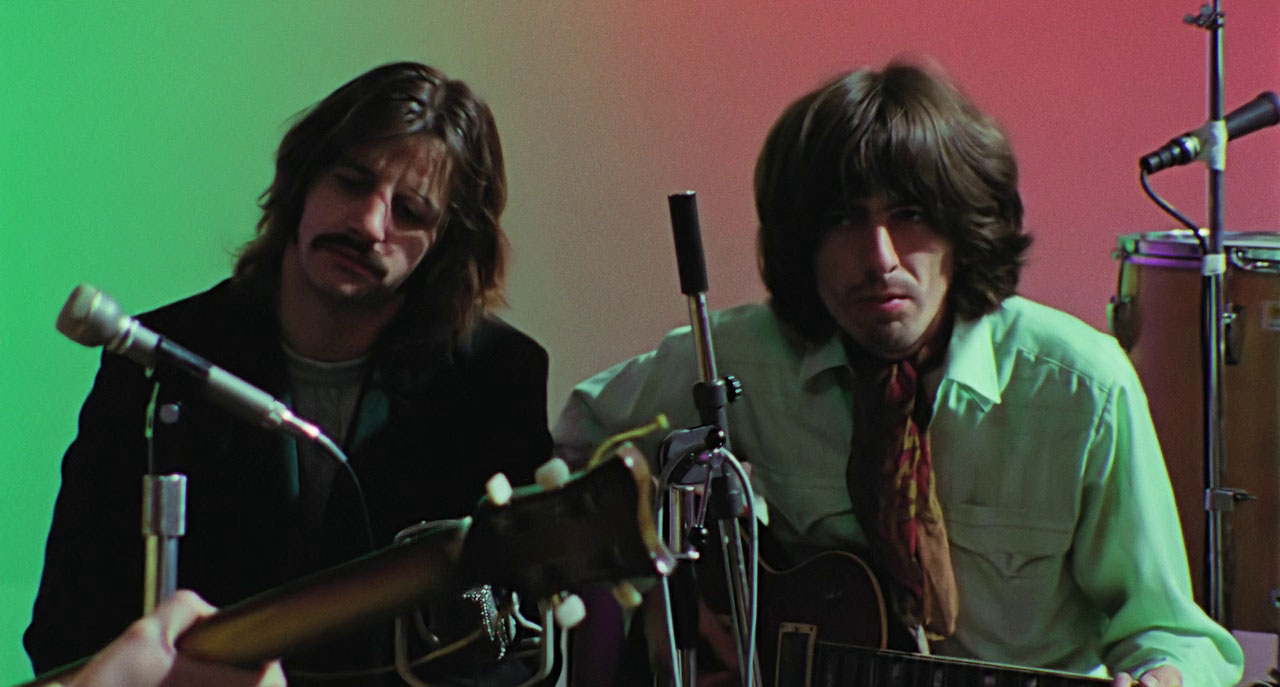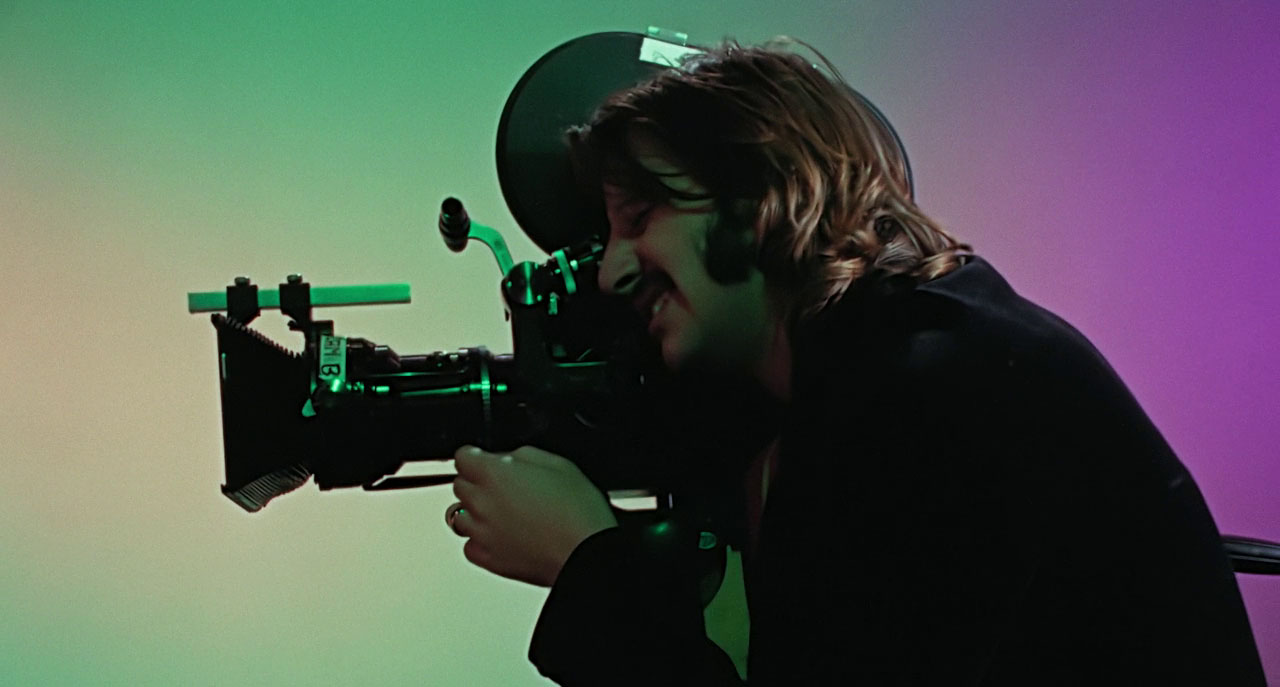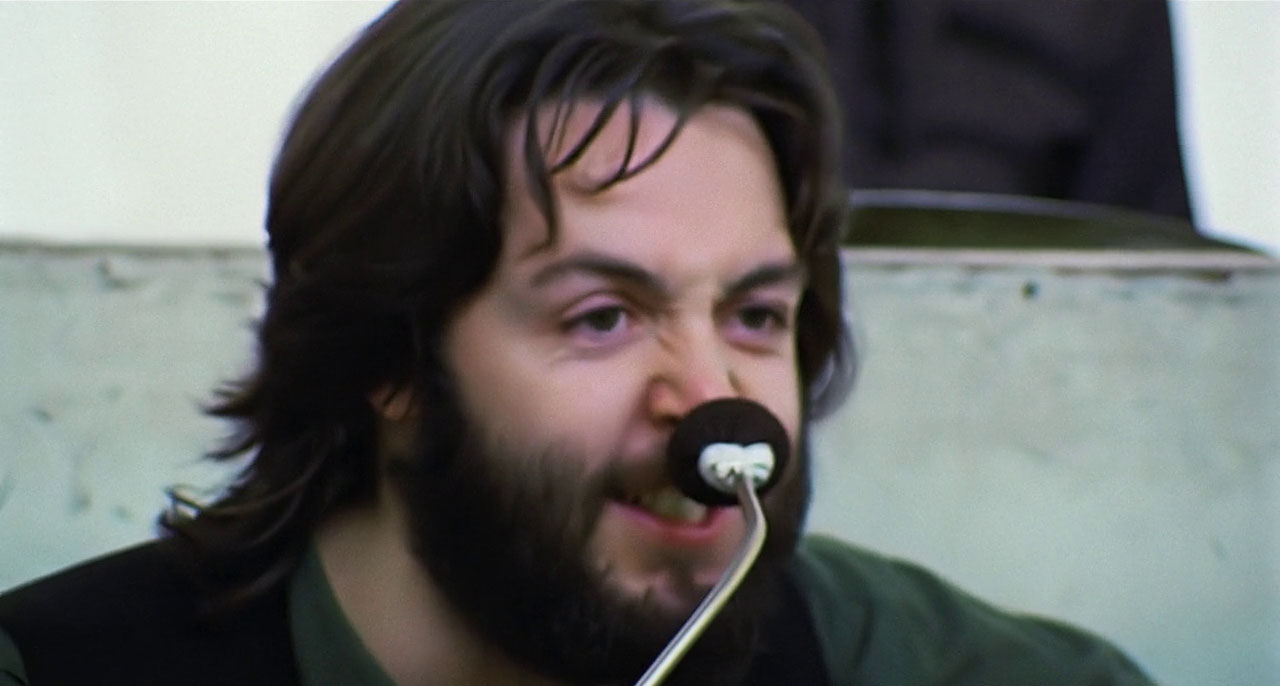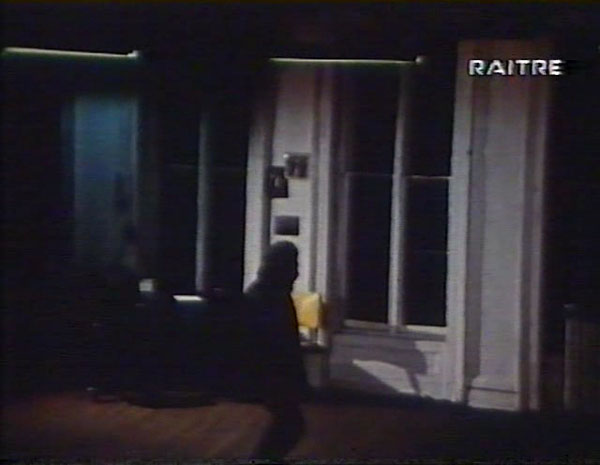The doc companion to I Wanna Hold Your Hand.
Murray the K, Ronnie Spector, Smokey Robinson (!), and Little Richard all appear.

Unfair sneak attack by music lover David Lynch made me very upset and gained this movie an extra star.

The doc companion to I Wanna Hold Your Hand.
Murray the K, Ronnie Spector, Smokey Robinson (!), and Little Richard all appear.

Unfair sneak attack by music lover David Lynch made me very upset and gained this movie an extra star.

Katy picked this, an accidental sequel to my series of George Harrison docs. We got to see choice clips from The Long Good Friday and Mona Lisa, Time Bandits and Withnail and I, interviews with lead actors and Pythons and so on… a successful Saturday night.
Feels like an outtakes shuffle of pre- and early-Beatles stories with long lingers on old photos and scraps of George solo songs, then finds its footing as the Beatles start losing theirs, around the 1hr mark as drugs turn to meditation and Ravi Shankar and the gurus enter the picture. As he uses clips from the Get Back sessions and the Concert for Bangladesh, my Beatles movies are starting to eat each other. Conclusions: George was a beautiful man, and Yoko didn’t break up the Beatles – Eric Clapton did.

Couldn’t You Wait (2013, Seth Pomeroy)
I finally got over my terror of watching this, thinking it would be too sad. Contains some of the stories I’ve long wanted to hear – Albini recording them at no cost, why/how they changed labels. Pomeroy does a great job editing the live and studio material together, and includes a feature-length “Live Worm” compilation of concert songs. I’m only halfway through the other extras – it’s a treasure trove. “If you cant get into Silkworm then God hates you and you’re an asshole.”

–
The Concert for Bangladesh (1972, Saul Swimmer)
Continuing my post-Get Back solo Beatle explorations (albums played so far: Ringo x1, John x2, Paul x3 and All Things Must Pass). My 2003 AVI file often looks better than the HD Peter Jackson movie, hmmm. George introduces Ravi Shanker, pleading with the crowd to follow along (it’s “a little more serious than our music”), then tears through some “All Things” hits. Billy Preston and Ringo and Leon Russell get vocal turns. “While My Guitar” and “Here Comes the Sun,” a four-song Bob Dylan feature, then a couple closing numbers. Happy to discover it’s another one of the great concert films.
George, Bob, Leon:

Ravi and company:

–
This Much I Know to Be True (2022, Andrew Dominik)
Dominik repeats his One More Time With Feeling feat of having each song be visually distinct, maybe more impressive here since he’s got a limited toolkit in a single location and keeps showing us the tools (lights, dolly tracks) yet somehow surprising us within the moment. Another difference is that I already loved “Skeleton Tree” before watching the previous movie, while this one revealed the beauty of “Ghosteen” and “Carnage.”


Some notes I took along the way:
Day 2 opens with them looking thru Beatles fan magazines
Michael L-H is kinda an ass
Cutting between 1966+69 on “Rock & Roll Music” at end of day 4 is great
Mal is round-headed guy who plays anvil on Maxwell’s


We know that it’s magic to spend time with the Beatles, but episode two presses its luck, showing us different views of a flowerpot while John and Paul argue near a hidden mic
Peter Sellers shows up after The Magic Christian sets arrive
Reminiscing on their India trip, discussing the footage, which we get to see



Michael and Glyn are credited with the roof idea
Jackson has overbaked everything since Frighteners
Soon before the concert, John simply sings the setlist, wow
During the concert the movie thinks we want to hear everything the teenaged chinstrap-chewing pigs say, but we’d like to hear the music please
Problems with the crowd interviews on the street: British people are boring, and clearly Beatlemania is over




Beatlemania is back on in our house, though.
Aspirational Post-Beatles Media To-Do List
– The Magic Christian (1969)
– Ringo: Beaucoups of Blues (1970)
– George: All Things Must Pass (1970)
– John/Yoko: Plastic Ono Band (1970) + Imagine (1971)
– Paul: McCartney (1970) + Linda/Ram (1971) + Wings/Wild Life (1971)
– The Concert for Bangladesh (1972)
– Concert for George (2003)
– Beatles Anthology (1995)
– Beatles Love (2006)
– Rock and Roll Circus (1968)
– How I Won the War (1967)
– The Last Waltz (1978)
– Jimi Plays Monterey (1967)
– George Harrison: Living in the Material World (2011)
Anticipating a new wave of Beatlemania on twitter when Get Back dropped, I watched this in early Nov. I always catch a new Yo La Tengo reference when I watch a Beatles movie – last time was in Help!, dreaming ’bout Eleanor Bron, seeing her in the arms of Paul saying “I can say no more.” This one’s got a cameo by New York DJ Murray the K, who must be the inspiration for Ira’s DJ name.

Three girls and two boys experiencing different levels of Beatlemania in Maplewood NJ drive into the city to crash the Beatles’ Ed Sullivan Show appearance in NYC. No actual Beatle involvement, just stand-ins, glimped from below or behind with impersonator accents. Silly idea for a movie, pulled off wonderfully, an ensemble piece with an ever-growing ensemble, an awful lot of Beatles songs and a woozy happy ending.
L-R: Pam, Janice, Grace, Rosie

Rosie’s the emphatic one who wills the trip into action (Wendie Jo Sperber, Marty’s sister in Back to the Future), Pam is her bestie who plans to elope with her boy tomorrow (Nancy Allen’s followup to Carrie), then there’s Photographer Grace (Pesci’s wife in Raging Bull) and Protester Janice (Susan “daughter of Paul” Newman). Tony is basically a stowaway, out to cause trouble (Bobby Di Cicco of The Big Red One). Larry’s the Cameron-in-Ferris-Bueller of the gang (Marc McClure, aka Jimmy Olsen in Superman), borrowing his undertaker dad’s limo to get them all close to the hotel.
The theater has posters for Wild Strawberries and The Cranes are Flying:

In charge of security on the Beatles floor is Dick Miller – Pam gets by him inside a drink cart and spends quality time with the bands’ instruments while they’re out. Grace and Larry fail to raise cash by selling scraps of Beatle bedsheets, then she tries being a call girl but settles for extortionist instead. Janice and Tony befriend a mophead kid whose dad has tickets but will only give them up if the kid gets a haircut. And Rosie capers with a Beatlemaniac nerd called Ringo (Eddie Deezen of Grease the same year).
Miller grabs Grace:

Handheld b/w, a low-budget shoot but always terrific-looking in sharp focus. Not Lester’s first feature – why do you never hear about It’s Trad, Dad or Mouse on the Moon? DP Gilbert Taylor shot Dr. Strangelove the same year, Repulsion the following.
It has more of a story than most concert movies but much less of a story than most non-concert movies. The premise is that the guys catch a train to the city, have to rehearse and then film a TV appearance, but they keep wanting to run off and play and insult people.
As Paul’s clean grandfather, Wilfrid Brambell, known for playing comic character Albert Steptoe. As the two guys responsible for getting the boys through their day, Norman Rossington (Saturday Night and Sunday Morning) and TV writer/actor John Junkin. Uptight sweater-wearing TV director Victor Spinetti would return in Help! the following year.
I passed up seeing The Scarlet Empress in 35mm for this, but it was probably worth it [later note after having finally watched The Scarlet Empress: nope].
Meshes of the Afternoon (1943, Maya Deren)
One of the great poetic movies of the 40’s. Love when she’s climbing the stairs, bouncing off the walls as the camera twists from side to side. Love the multiple Mayas sitting at a table in the same shot (technically impressive, too). Love the movement, the plot (avant-filmmakers take note: an actual plot), the look, that iconic shot of Maya at the window.
Fuses (1967, Carolee Schneemann)
Fairly rapidly-edited shots of director having sex with James Tenney, with other scratched and weathered colored filmstrips superimposed over it. The editing and content are exciting for about ten minutes, but the movie is twenty minutes long, and silent. Girl in front of me tried reading from the reflected light of Tenney’s alarmingly red-tinted penis on the classroom wall, then texted people for a while. I sat wondering why there were so many shots of her cat staring out the window. Maybe it was supposed to be boring, and that was the point. Worth watching on pristine 16mm, glad I saw it, just saying it felt long. Schneemann has few film credits, but they’re in collaboration with Andy Warhol, Yoko Ono and Stan Brakhage. The Brakhage influence can plainly be seen here, and the film process work makes for some wonderful images. This was apparently a reaction to the objectification of women in movies, with Window Water Baby Moving named as an example. The director: “I wanted to see if the experience of what I saw would have any correspondence to what I felt – the intimacy of the lovemaking… And I wanted to put into that materiality of film the energies of the body, so that the film itself dissolves and recombines and is transparent and dense – as one feels during lovemaking.” Won a special jury prize at Cannes.
Reassemblage (1982, Trinh T. Minh-ha)
Black with ambient sound. Then shots of a rural scene in Senegal with silence. More shots with narration. More shots with ambient sound. More narration. Eventually, more black. The sound is rarely commenting directly on the visuals, and even the ambient sound rarely seems to line up. Shots of bare-breasted African women, daily chores, kids (two albinos!), youth playing in the river, and so on, with comments about ethnography. The commentary might make sense written down, but as we heard it, all scattered and edited (the sound editing was pretty poor), it seemed to circle around some points without managing to make any. Got nothing against the film, was fine to hang out in Senegal for a while. L. Thielan: “By disjunctive editing and a probing narration this ‘documentary’ strikingly counterpoints the authoritative stance typical of the National Geographic approach.”
Reassemblage:

First Comes Love (1991, Su Friedrich)
Pop music by the Beatles, James Brown, Willie Nelson and more, but someone please get this woman a cross-fader – it’s all so abruptly edited. The songs sometimes work really well with the images, though. Image is of four wedding ceremonies, astoundingly woven together into an ethnographic study of heterosexual marriage ceremony, interrupted by a text crawl of all the countries in which homosexual marriage is prohibited (every country but Denmark). Bell & Zryd: “This simple strategy, which contrasts the lush life of heterosexual ritual with the stark legal and constitutional realities of gay and lesbian relationships, reframes the anthropological text with political rigor.” Rigor isn’t something I look for in a movie, but avant-critics love to proclaim it. What rigor! Anyway, would like very much to see more of her work.
Girlpower (1992, Sadie Benning)
I hear the intro feedback of a Sonic Youth song and all is right in the world. Even though this movie (the shortest of the bunch, I expect) is a half-res crap-quality videotape, the music and narration are clear. About the narration – sounds like either a petulant girl or a woman in performance-art mode… an impressionistic video diary of disaffected youth, comfortable with herself but not with society. Aha, Benning was 30 at the time. Lotta shots of the television. Punk film, but with nicer sound editing than the Friedrich, weird. Short, enjoyed it. Ooh, she’s James Benning’s daughter.
Thanks to Andy, I finally had the chance to see one of the most talked-about avant-garde films of all time. While it’s important to talk about experimental film, it’s more important to actually see the damned things – and while anyone can order a copy of Visionary Film for $26.95, it’s nearly impossible to see Wavelength on any given day.
Unfortunately, it’s one of those times (see also The Leopard) when I check out one of the Great Important Works of Cinematic Art and come out less than impressed. I didn’t find the audiovisual experience very enlightening compared to the descriptions I’ve read of the film. Didn’t dislike it (though I came close to disliking the soundtrack) but not an overwhelming experience like Zorns Lemma, either. A few updates to those written descriptions: (1) It’s not a single, continuous zoom a la Last Days – the zoom moves sporadically and the camera slightly changes position from time to time. (2) There’s sound – a sinewave tone that starts low and ends high, with other quieter tones joining it at times and sync sound during the four action scenes. Those action scenes: Woman gets bookshelf delivered, two women listen to “Strawberry Fields Forever”, man dies, girl makes phone call expressing concern that there’s a dead man in her apartment. (3) There’s a twist ending – after zooming the full length of the apartment, the photograph on the wall is of waves in the sea. I get it, ha ha. After reading Sitney and Snow, I see why the movie is interesting, even exciting in theory, but the viewing experience just wasn’t there… wouldn’t want to see it again anytime soon.
P. Adams Sitney: “This is the story of the diminishing area of pure potentiality. The insight that space, and cinema by implication, is potential is an axiom of the structural film.”
Snow: “I wanted to make a summation of my nervous system, religious inklings, and aesthetic ideas. I was thinking of planning for a time monument in which the beauty and sadness of equivalence would be celebrated, thinking of trying to make a definitive statement of pure Film space and time, a balancing of ‘illusion’ and ‘fact,’ all about seeing. The space starts at the camera’s (spectator’s) eye, is in the air, then is on the screen, then is within the screen (the mind).”
Hollis Frampton: dead man:

Actors included Joyce Wieland and Hollis Frampton (as the man who dies). Assisted by Ken Jacobs, and sound by Ted Wolff, who unsurprisingly didn’t do any other film sound after this. Snow screws with the camera a bunch: focus, filters, film stocks (supposedly – I hardly noticed), light settings, time of day and lighting inside, etc. My favorite part is one or two frames where the picture on the wall towards which we are slowly zooming is highlit by a sunburst of drawn lines (screenshot below). I’m glad I got to see it anyway, and glad Andy played this and not Warhol’s Empire or something.

When I got home, watched WVLNT (2003) and Prelude (2000). The former was a shortened version of Wavelength “for those who don’t have the time” – he cut the movie into three equal parts and superimposed them. Except for the now-intolerable soundtrack, I liked this version much better! There’s much more to look at.

Prelude was a cute intro bit from the same Toronto Film Festival that brought us The Heart of the World. It’s hard for me to tell exactly how cute since my copy is such low-quality (think it came from streaming realvideo on the TIFF site), but it seems to be a single camera take, clean picture on a clean set, with unsynched sound edited in all over the place – actors and film crew talking about films in general and the one they are presently inside. This and WVLNT travel a similar road as Snow’s SShtoorrty, with its color-coordinated set, single camera move and superimpositions.
